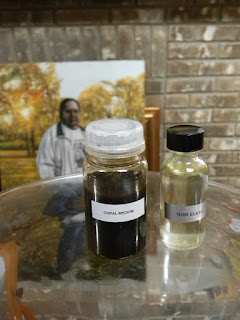
This series of posts was completed for artist Graydon Parrish, to assist with his lecture on a particular painting (
William Bouguereau's Nymphs and Satyr) as completed by William Bouguereau (http://grandcentralatelier.blogspot.com/2012/03/graydon-parrish-to-lecture-at-clark.html). It is a description of this material, and the reasons for its use. Nothing in these posts is an encouragement of others to make or use this medium, and is stated merely as a description of the material, and how I have made it.
It is a known fact that William Bouguereau used elemi, and copal in his work. In the world of art, and more specifically, oil painting, there have always been mediums, used for various effects. I don't wish to enter into debate with those who believe that all effects known to oil painting, can be accomplished with just drying oil alone. Although I do respect the opinions of others. I do not believe this, and in experimenting with many different mediums, have found that some provide effects that oil alone will not accomplish. Amber, copal, and many others.
Gum elemi has been of interest to me, for quite a few years. Years ago, at the Toledo Museum of Art, I had the opportunity to study a painting by William Bouguereau. I noticed that the surface of the paint film was absolutely smooth. No raised spots or even brush strokes visible. The image was of a girl, and all of the edges were fused. The image created an effect of being more real, than a photo. Based my observation, I became convinced that something more than oil paint alone was used to create the work. A bit of research led to an understanding that copal and elemi was used by that artist, as a medium. This led to experimentation with elemi, and although I have never come close to creating a work, such as that artist, I have noticed that the mediums which contain copal and elemi permit some comparable effects.
Gum elemi derives from trees in the Phillipines, Southeast Asia, and other locations in the tropics. It is a balsam, although cloudy in appearance, and not at all like the other balsams, upon initial consideration.
It was used in the past as a plasticizer for varnishes, as it was known to remain flexible, and this can be beneficial, to prevent cracking to crystalline varnishes applied over an oil film.
Used as a medium, elemi would be of no use by itself, as it is initially too viscous, and would not impart any benefit to oil paint, in its raw state. Once processed however, I have found that this material imparts some quite impressive effects. In using it as a medium, the plasticizer effect is helpful, but there is an additional effect of permitting paint to tack up while remaining wet, and I don't think that anything provides a better blending effect. Although Canada balsam, and Venice turpentine permit paint to blend quite well, gum elemi surpasses them, in my opinion.
Bouguereau used various mediums in creating his work, and it is known that he combined gum elemi, with hard copal medium. This medium is quite impressive, in that it permits all of the effects of copal, while allowing for a better blending effect, is thinner initially, and again, acts as a plasticizer.
The picture above is gum elemi in its unprocessed form. It is very viscous, and yet will flow very very slowly over time.



























